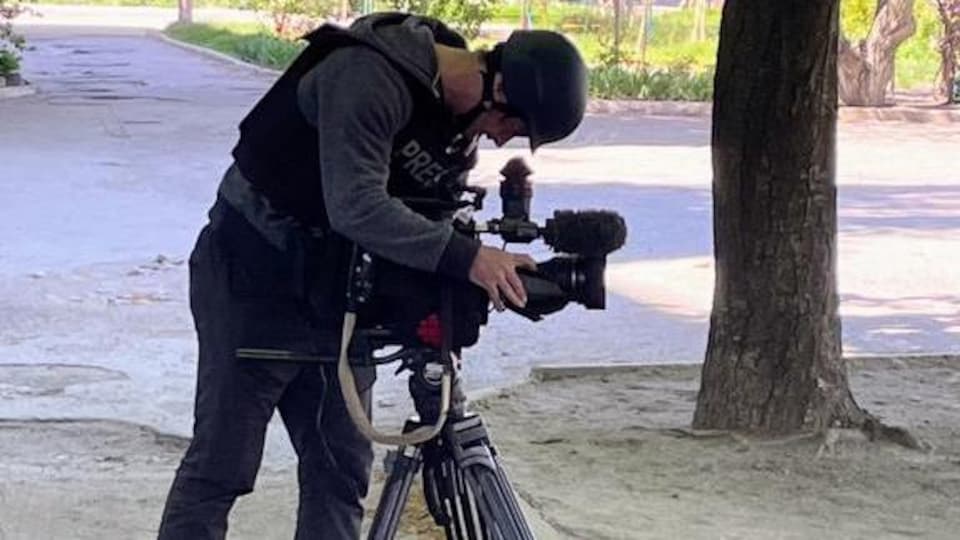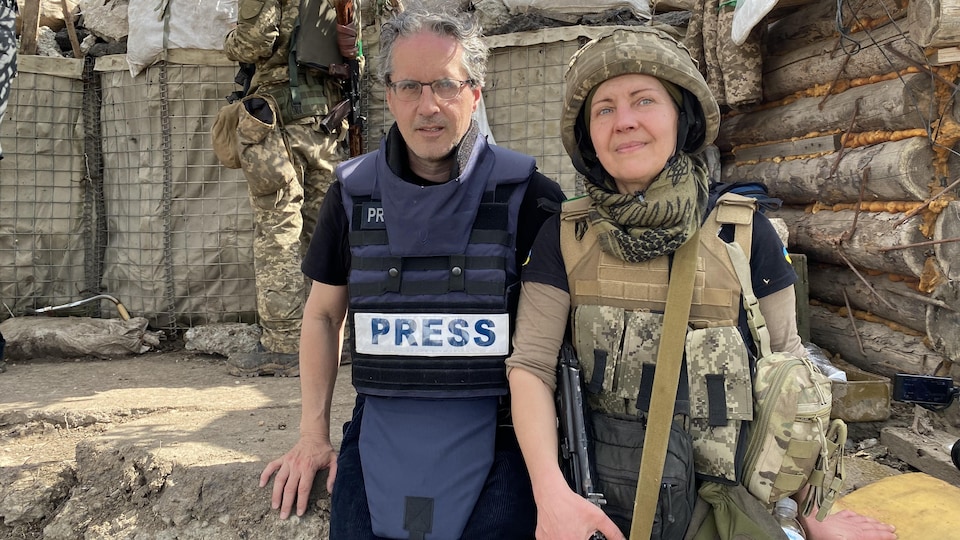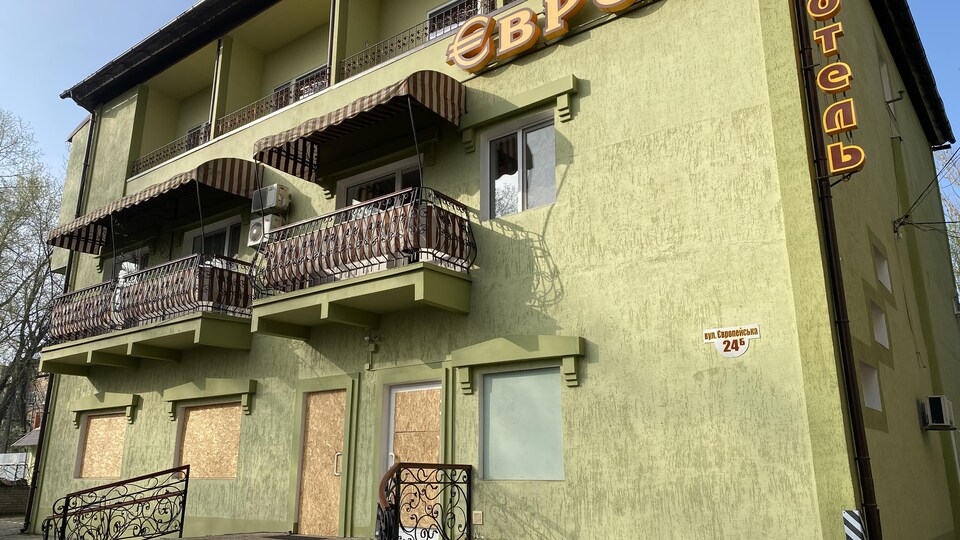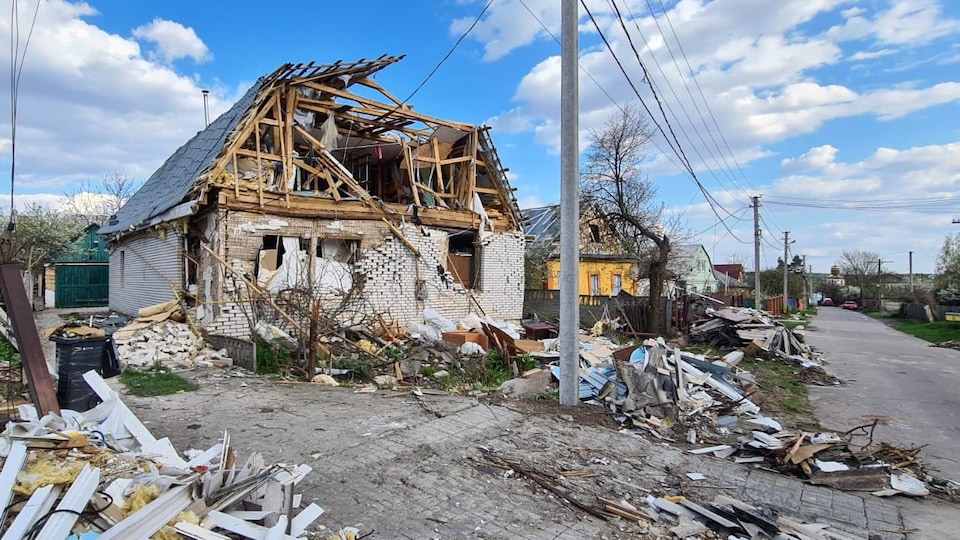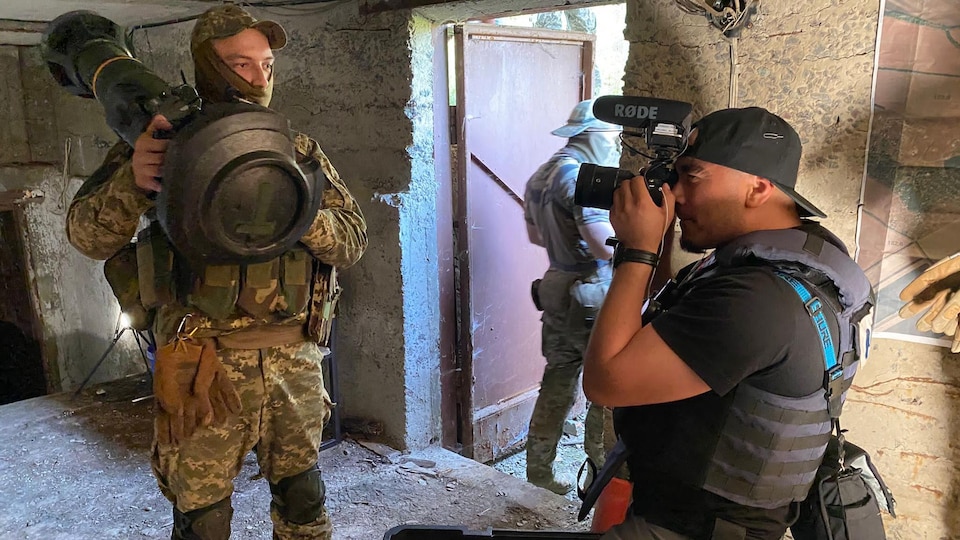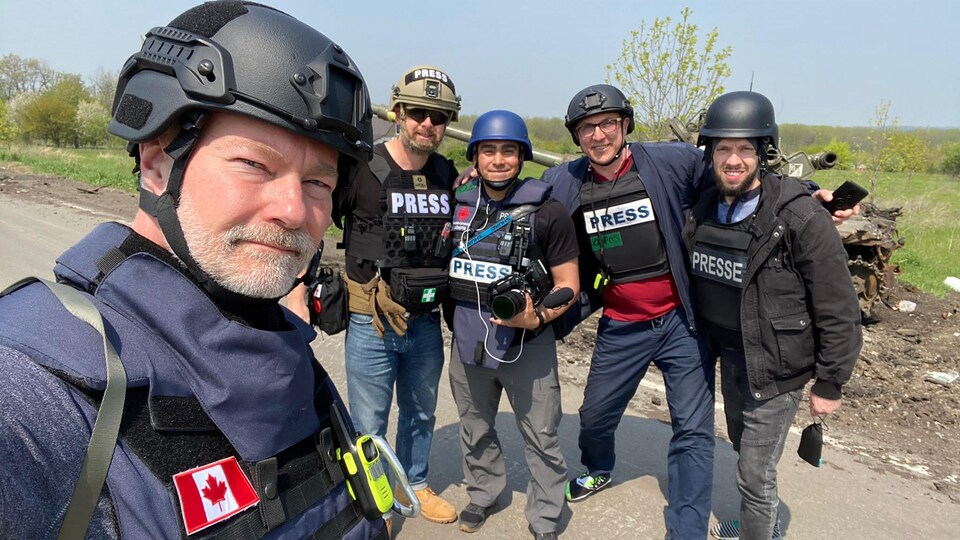They covered natural disasters, epidemics or the guerrillas in Colombia. In recent months, it is in a ruined Ukraine that they plunge, camera in hand and heart in stomach. Cameraman-editors Maxime Beauchemin, Frédéric Tremblay and Emilio Avalos talk about their experience.
Everything seemed surprisingly calm when we entered Orikhiv. Every day, however, war approaches.
In the voiceover, Céline Galipeau narrates. A moving camera shows us this small sunny but deserted town, 60 kilometers from Zaporizhia, in southeastern Ukraine.
On this day in May 2022, the Radio-Canada team included the anchor of Newscast is less than two kilometers from the front.
We heard bombardments, recalling cameraman-editor Maxime Beauchemin. In the morning, a Russian missile hit a kindergarten; a daycare was hit. It’s good to have no children, but …
Thick smoke hung on the rubble that was still burning. It’s still fresh, rock dust is falling, you can see the impact, shells, all that.
His camera is slung over his shoulder, the same one he uses to cover politics, sports or public affairs in Toronto, where he usually works. I knew him while closing my eyes, he explains. She weighs 9 kilos, but she doesn’t feel it. You get used to it, you’re part of it.
For filming in Orikhiv, Grant Bowden, the team’s security manager, saw everything: roads, entry points, exit points.
Before entering, members of the radio-canadian team stopped at a service station to get dressed properly helmets and bulletproof vests with the word “MEDIA” prominently on the chest plate.
Grant explained to us the plan, Maxime Beauchemin said. “We’re going to get there, we want to go there, and if ever we have to leave fast, we have option A, option B, option C”.
Basic rule: never get stuck.
The choice was made quickly. We weren’t there as tourists, the cameraman described. We took pictures, we talked to the people we wanted to talk to, and then it was like, “We have everything? Yes? OK, let’s go somewhere else”.
The instruction, provided by Radio-Canada’s direction in Montreal, is clear: don’t drag on Orikhiv.
Logistics, engineering and humanity
Cameraman-editor for more than 15 years, Maxime Beauchemin has been to Haiti three times, including twice in the company of a security officer. Insurance forces us to do it now.he explains.
Grant Bowden, who is with Céline Galipeau and her team in Ukraine, is also an ambulance technician. If the team suffered any injuries, he gave first aid immediately.
In Orikhiv, the Russians hit a seed warehouse. Wheat is to feed the local population … The fire broke the warped tin roof, which collapsed. On the camera, the images rush.
This important visual will be provided to Radio -Canada in Montreal using transmission boxes – Dejero and LiveU – equipped with cellular cards.
In television, proper technical functioning is essential. No picture, no story.
And in Ukraine, no worries in this matter. Cellular coverage is still very solid, Maxime Beauchemin describes, we have no connection problems. The signal is consistent and strong from start to finish.
After 57 days spent underground, Céline Galipeau says in the report to the survivors of the Azovstal factory in Mariupol, little Ivan, one and a half years old, no longer walks alone; he needed reassurance. Worried, the blond child stared at the sky in the sunlight.
When part of the survivors arrived in Zaporizhia, 250 km northwest of Mariupol, they were surrounded by a herd of journalists and asked questions directly. Ilia, the young Ukrainian guide-interpreter on the Radio-Canada team, was shocked.
He told us: “Let them come, calm down!” says Maxime Beauchemin trying to film the crowd, with people hugging me and blowing my back.
TV isn’t always done so harshly, he nuances. We can show emotion indirectly on the person’s face. Our cameras have focal lengths, which allow us to turn back.
” When you step aside, the person is more comfortable and he is able to tell his story, to say what he has to say. “
Although eager for photos, cameramen are capable of modesty. Reserve.
I know that Radio-Canada will not put a beheaded head on the air. So I didn’t take him much [de la filmer].
The speaker was Frédéric Tremblay, cameraman-editor who was twice sent by Radio-Canada to Ukraine along with journalists Philipe Leblanc and Jean-Michel Leprince.
With experience in the informational business, this hard-working cameraman has covered the Ebola epidemic in Africa, the deportation of Haitians dreaming of a better future or even the FARC guerrillas in Colombia.
In addition, he is a journalist and speaks Russian. Speaking the language is a treasure! It’s easier.
He learned this language at Laval University in the 1990s and then made it perfect during his long stay in Russia.
And, although he did not master the Ukrainian, he found himself in his element in this country, he who had been to Lviv twice and to kyiv four or five times.
But no one is preparing for the scale of the destruction. With sirens sounding day and night, for an hour straight. At the roar of guns, a few kilometers from the front. People often ask me, “Are you scared?” and I said “No”. Not because of overconfidence! I have a lot of background: I may have traveled 50 countries using Radio-Canada and alone […].
Tough image, he shot. I can say we are somewhat protected by the viewfinderhe moves forward to explain this kind of detachment to him.
where they should be
During filming, Frédéric Tremblay had an eye on the camera and … eyes and ears around his head.
” I am very alert. I see this or that action, I know the journalist wants it. And I say to myself: if I have to do this story, how do I want to cover it up? “
Once, Frédéric Tremblay left alone with his camera. Like the night when, in kyiv, he wanted to get the golden hourthe golden light of the end of the day in the gleaming domes of St. Sophia at St. Alexander Nevsky cathedrals. It’s flashing […] I enjoyed it.
” Our grief is insignificant compared to the suffering of others. Let us not forget that many died. “
On February 24, 2022, the first day of Russia’s invasion of Ukraine, the decision was made in Demydiv to blow up a dam to block the passage of Russian tanks towards kyiv. And it worked, says journalist Jean-François Bélanger in his report, the Russian soldiers did not pass.
Jean-François Bélanger’s cameraman-editor is Emilio Avalos. Attaching the camera, microphone tripod and lighting equipment, he was accustomed. But his equipment now includes a gas mask. This was his first experience in a war zone.
On the farm, his days last more than ten hours. Then it is necessary to proceed to the assembly of images and to prepare the day for the next day. This large bearing is physically and mentally demanding, he admits.
His camera captures beauty and misfortune interrelated.
In Demydiv, after the dam was blown up, Hryhorii Dziuba saw his vegetable warehouse flooded. His cow and calf almost drowned.
In the barn, the cow gently licked the sexagenarian’s threaded sweater. This is the inner part of the TV: sensitivity crushes the heart and breaks the screen.
” Immediately, with adrenaline, you will see the damage. When you talk to people directly affected, that’s where you are touched. You become aware of the work you are doing. “
With experience, he says, you learn to distinguish between what you give back to you and what you leave behind.
All of them, Maxime Beauchemin, Frédéric Tremblay and Emilio Avalos, said they were privileged to perform this type of assignment. Not that they’re happy to be in a war zone … But they’re where they belong.
Everyone knows that their trade is in Ukraine right now, says Emilio Avalos. They are great! I feel privileged to say: I am there, with them.
Source: Radio-Canada

